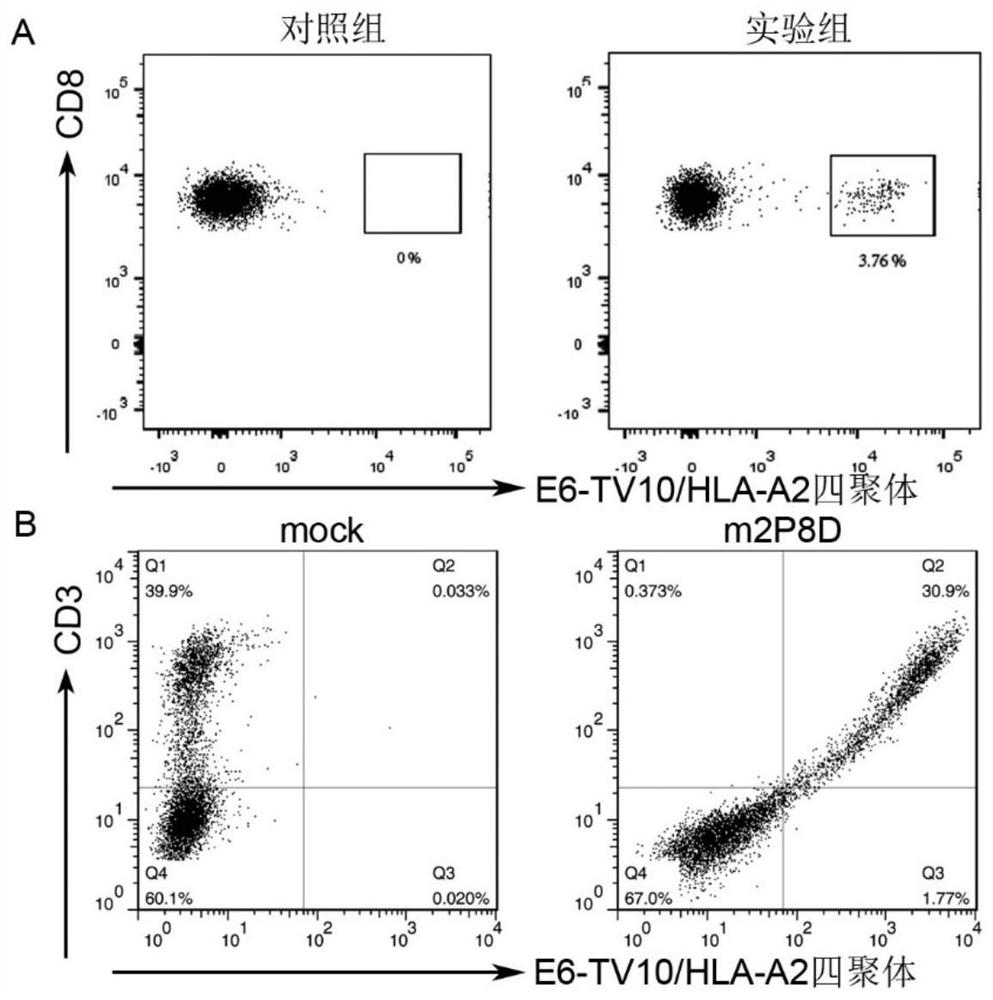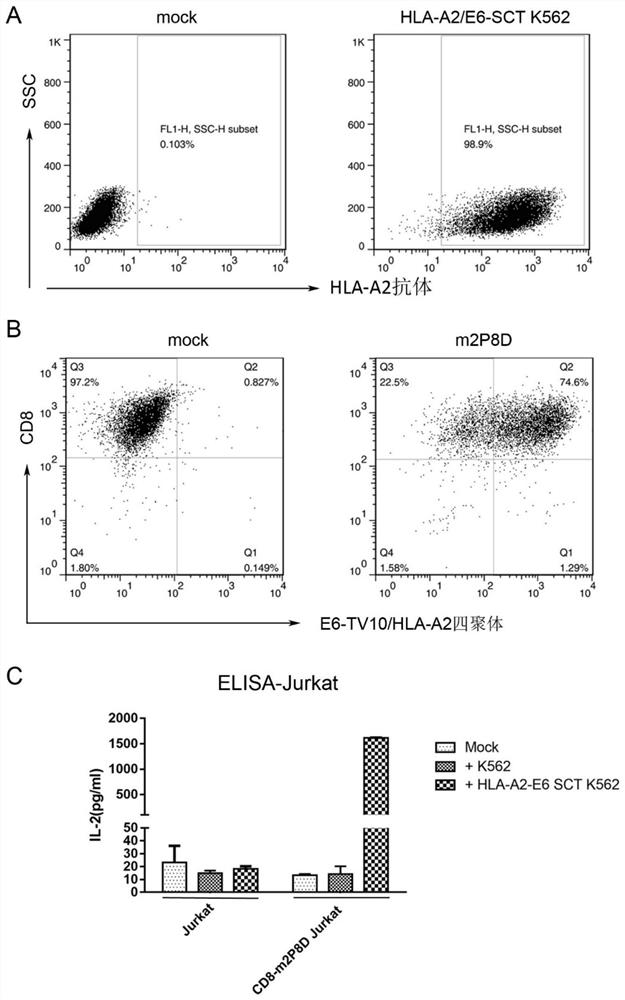Human papilloma virus specific T cell receptor and anti-tumor application thereof
A human papilloma virus and cell receptor technology, applied in the field of medicine, can solve the problems of p53 inactivation, hinder the inhibition of p53 protein, etc., and achieve the effects of high binding characteristics and high infection efficiency
- Summary
- Abstract
- Description
- Claims
- Application Information
AI Technical Summary
Problems solved by technology
Method used
Image
Examples
Embodiment 1
[0065] Example 1. HPV virus E6 antigen TV-10 polypeptide specific T cell sorting and TCR gene cloning
[0066] First, the inventors synthesized HPV-16 virus E6 antigen HLA-A2 restricted epitope polypeptides, and used these polypeptides to immunize mice, and selected immunogenic mutant polypeptides through ELISPOT experiments. The amino acid sequence of the polypeptide is shown in SEQ ID 21, which is the HLA-A2 restricted epitope polypeptide TV-10 of the present invention, and is sometimes referred to as polypeptide TV-10 or TV-10 polypeptide hereinafter.
[0067] Subsequently, the tetramer of TV-10 polypeptide and mouse HLA-A2 was prepared by using it, and CD3 was selected from splenocytes of immunized mice by staining with CD3 and CD8 antibodies together. + CD8 + T cells were sorted to obtain TV-10 epitope-specific T cells. details as follows.
[0068] 1. Preparation of TV-10 / HLA-A2 tetramer
[0069] The binding characteristics of polypeptide TV-10 and HLA-A2, specific T ...
Embodiment 2
[0107] Example 2. Binding experiment of TV-10 polypeptide / HLA-A2 tetramer and cells expressing m2P8D TCR
[0108] In this example, the inventors further confirmed that the screened m2P8D TCR has specific binding to TV-10 polypeptide / HLA-A2.
[0109] 1. Verification of m2P8D TCR binding specificity
[0110] First, the α-chain and β-chain variable region (V region) of m2P8D TCR (amino acid sequence shown in SEQ ID NO: 1, SEQ ID NO: 5, respectively, and the α-chain and β-chain constant region (C region) of human TCR ) gene (synthesized by Hongxun Biological Co., Ltd.) to obtain m2P8D chimeric TCRα and β chain sequences. The amino acid sequence of the chimeric sequence is shown in SEQ ID NO: 9, and its nucleic acid sequence is shown in SEQ ID NO: 10.
[0111] And the α-chain and β-chain of m2P8D TCR are connected with the P2A sequence (the amino acid sequence of the P2A sequence is shown in SEQ ID NO: 26), and the lentiviral expression plasmid pCDH (purchased from Invitrogen) is ...
Embodiment 3
[0117] Example 3. Effector cells expressing m2P8D TCR interact with target cells expressing E6-TV-10 / HLA-A2
[0118] In this example, the m2P8D TCR gene was introduced into the Jurkat T cell line (purchased from Shanghai Cell Bank) as effector cells; E6-TV-10 / HLA-A2 was introduced into K562 cells (purchased from Shanghai Cell Bank) as target cells . The effect of m2P8D TCR on target cells expressing E6-TV-10 / HLA-A2 was evaluated by detecting the levels of IL-2 after effector cells and target cells. The specific operation is as follows.
[0119] 1. Preparation of E6-TV-10 / HLA-A2 target cells
[0120] According to the codon expression of eukaryotic cells, the DNA sequence of the gene encoding polypeptide TV-10 and HLA-A2 heavy chain and β2m is optimized, and the nucleic acid sequence obtained by sequential connection is called TV-10 / HLA-A2-E6 SCT, and the sequence is as SEQ ID Shown in NO:12, its coded amino acid sequence is shown in SEQ ID NO:11.
[0121] The above DNA was ...
PUM
 Login to View More
Login to View More Abstract
Description
Claims
Application Information
 Login to View More
Login to View More - R&D
- Intellectual Property
- Life Sciences
- Materials
- Tech Scout
- Unparalleled Data Quality
- Higher Quality Content
- 60% Fewer Hallucinations
Browse by: Latest US Patents, China's latest patents, Technical Efficacy Thesaurus, Application Domain, Technology Topic, Popular Technical Reports.
© 2025 PatSnap. All rights reserved.Legal|Privacy policy|Modern Slavery Act Transparency Statement|Sitemap|About US| Contact US: help@patsnap.com



